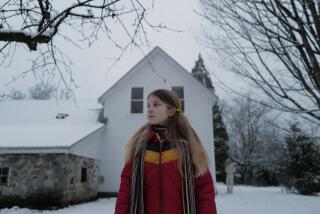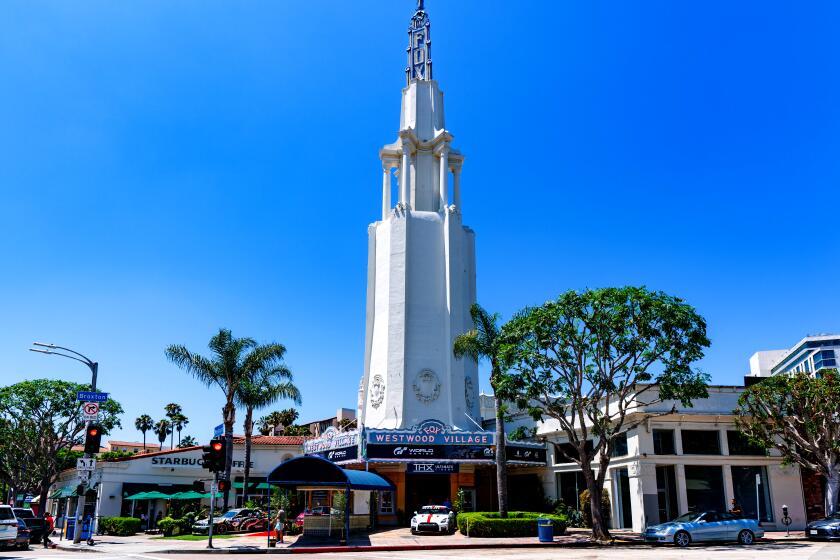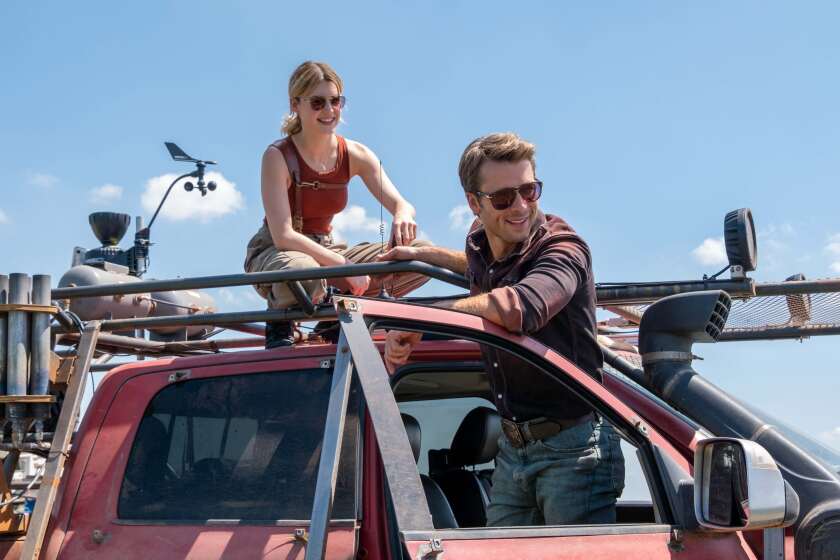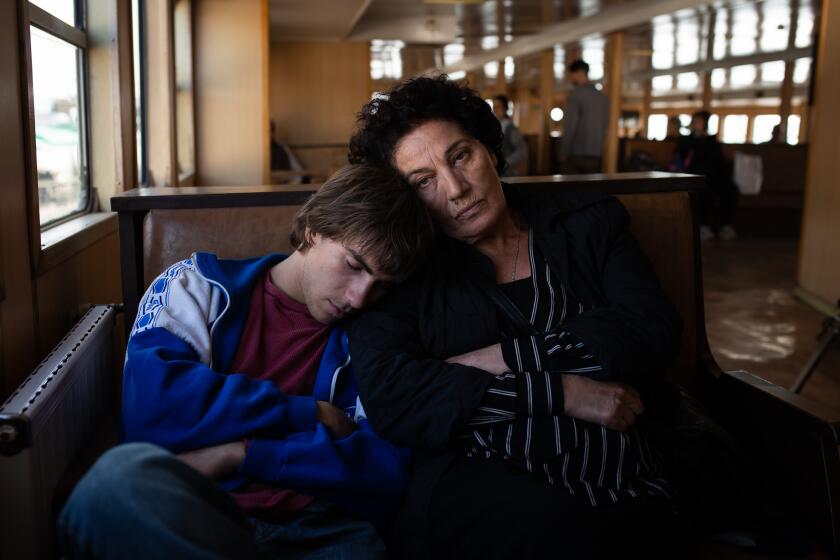ON LOCATION : Does White Water Become Her? : Two-time Oscar winner Meryl Streep leaves serious drama (and her accents) behind in ‘River Wild.’ (Who the heck does she think she is, Bruce Willis?!?)
Meryl the martyr. Meryl the multilingual. Now, Meryl the macha woman?
Up here in the wilds of western Montana, Meryl Streep is stretching as an actress: Aerobics. Machines. Yoga.
And she needs all the help she can get.
Mighty Meryl, conqueror of accents foreign and domestic, today is happy just to survive the many takes of running the treacherous rushing waters of the Kootenai River here, a.k.a., “The River Wild,” without flipping over. She is not always successful.
Streep plays an imperiled captive in the Bruce Willis/Steven Seagal vein--except, of course, it’s a she, not a he, who becomes heroic in the face of adversity. And she must rely as much on her wits as the guys do on hardware.
Playing Gail Hartman, hostage mom, Streep is trapped going down river over dangerous Class V rapids with two armed criminals, the deceptively charming Wade (Kevin Bacon) and his not-too-smart accomplice, Terry (John C. Reilly). Gail had planned this vacation to patch up her marriage to husband Tom (David Strathairn) and to celebrate the 10th birthday of her son Roarke (Joe Mazzello), who she hopes will come to appreciate the joys of the great outdoors. They live in Boston where she teaches the deaf ( another language) and her husband is a workaholic architect. The film will be released next summer or fall.
What expert river rats don’t often attempt, Streep, 44, is now facing. She has wrapped her palms with black gaffers’ tape to protect her bloody blisters from breaking open before gripping the heavy oars for another run through the Maytag--river talk for a churning mass of spilling white water.
Safety technicians in kayaks, moving like water bugs, paddle furiously in place off-camera as the actress looks nervously side to side, rowing backward into thundering rapids so loud they obscure director Curtis Hanson’s shout of “Action” through his megaphone. Four cameras, including one hand-held by kamikaze cameraman Mike Hoover dangling from rigging suspended above Kootenai Falls, roll simultaneously.
It looks hairy from the shore--even hairier in close-ups on the actress’s panic-stricken face through cinematographer Robert Elswit’s video monitor. This is no “River of No Return,” which was shot on a sound stage with Marilyn Monroe and Robert Mitchum tossed about on gimbals before a blue screen. Nor is it “Deliverance,” impressive enough as an action picture, but shot on a slow stretch of river wilderness.
Here, the river is a principal character--with one major distinction: It doesn’t take direction.
“There were reasons not to be drawn to (this movie) because you’re combining some troublesome elements involving nature . . . the old line that boat is a four-letter word . . . and we have a child, and a dog on top of that. So you’re into all kinds of nightmare things,” Hanson says, as his camera team, ankle deep in 55-degree water, is conferring on its next setup.
Three weeks into production, they are all too aware of trying to second-guess the precise point at which the raft will pass through their lenses. Forget about matching shots or worrying about the light changes; that’s left to Oscar-winning “J.F.K.” and “Born on the Fourth of July” editor Joe Hutshing. Those miles-wide thunderheads keep on rolling, meaning bright sunlight one minute, gloominess the next. The mantra seemed to be instead, “Please, God, just don’t rain.”
*
The challenge, when the core filmmaking team assembled at the Rogue River at Grants Pass, Ore., for pre-production and rehearsal in early summer, was how to achieve verisimilitude of the rafting experience. One solution, to devise a kind of raft equivalent of a car mount, with heavy Panavision cameras secured to the boat’s bow, tries to capture the tension from the water level: the river’s power, the boat’s undulations. R&D; “The River Wild” way.
“It use to be you turn on the fan and Marilyn Monroe’s hair blows a little,” Hanson says. “Now audiences want to be there, riding with the action.”
Fortunately, Hanson, whose last movie, “The Hand That Rocks the Cradle” for Interscope Communications and Hollywood Pictures, had a $16-million budget, gets more than twice that amount from Universal to cushion this unpredictable excursion.
At various times during the shoot, the union crew--moving from the Flathead River near Glacier National Park to the Kootenai, back to the Flathead and eventually on to Oregon--has numbered 160. There are a dozen people in the water safety crew alone. Two helicopter pilots are brought in from Coeur d’Alene, Ida., to transport everyone to and from location. World-renowned water sport experts like John Wasson, the river unit supervisor whose last film was “A River Runs Through It,” have given up their lucrative summer season to work on this movie.
Hanson’s droll understatement: “This is not a movie with motor homes around the corner.”
And there are environmental and spiritual considerations. This river gorge holds strong religious significance to the Kootenai Indians, who have asked a fee for its use, and with the U.S. Forest Service for certain conditions to be met: No trampling on sacred grounds (they are cordoned off, just in case); no cigarette butts left to decompose, and no sticky soft drinks or juice to further attract bees--just water, coffee and tea.
*
Libby (population 2,748) is a place where news of the world is hard to come by. Television programming is broadcast from Spokane, Wash., 110 miles to the west, which runs an hour later, meaning the morning news isn’t on yet by call time and evening news airs just about when everyone’s headed to bed. The quirky local radio station is low-frequency in all meanings of the term. For state headlines, there’s the Western News, which did a flattering write-up on “The River Wild”--though accidentally elevating the crew’s best boy grip to “playboy grip.”
When any of the actors are asked why they wanted to do “The River Wild,” the second reason given is usually Montana. (The first is always Streep.) Strathairn has brought his boys out from Upstate New York to hike. Kyra Sedgwick seems delighted to helicopter in at lunch so that her husband, Bacon (who says, grinning, “This is a blast and a half”), can play with their young son and baby girl.
And Streep, eight years after “Out of Africa,” says she was simply ready to work outside again: “I really loved that experience. I hate being in the studio all the time” (even if all the trappings of stardom seen on a set haven’t disappeared out here; her makeup man and factotum, Roy Hellend, lords over her as usual).
The actress says she’s done a near-180 turnaround from “The House of the Spirits,” in which she ages into a fairly sedentary 60-year-old grandmother in the Miramax version of Isabelle Allende’s novel, due in February. It shows too. Her tallish, thinnish, firmish physique fits right in with that of her character’s once-great sportswoman persona. Her pleasant but unspectacular looks sans makeup or flattering, feminine clothes also fit with being an outdoorsy gal of the West (minus the leathery skin).
“I wanted to physically engage in a way I never had on film,” she said.
*
Back before the cameras, Streep struggles to act while also struggling to row midstream for an establishing shot while the current fights her every stroke. This is her second day on the water and, while everyone agrees she is “awesome” (a favorite adjective with the crew) for a novice rafter, including the two world-class experts who alternate as her stunt and body doubles, Streep is not invincible in the face of nature.
By mid-afternoon, after a day of strenuous rowing, Streep misses the “green tongue” of moving water that could safely take her down through the lower part of the Gauntlet, the death-defying rapid in the film’s climax. In a split second, she’s in the frigid waters--her first real spill. That’s it for her this day.
Before taking off, the actress grabs a cup of herbal tea and sits in a sunny spot to warm herself, distracted by the yellowjackets. “Aw, go away! This is, uh, very unusual,” she says, swatting unsuccessfully at one. “The naturalists said it’s an epidemic.” She rubs her sore palms.
“God forbid anything like this ever happens to me (in real life),” she says of the exhausting experience, breaking into giggles. “I can barely negotiate the mall, honey.”
Certainly, when the project was announced back in the spring, Hollywood was abuzz with the news that this actress would even consider doing a movie in this genre. Yet the same was said of each of the comedies she’s done in recent years--”She Devil,” “Postcards From the Edge” and “Death Becomes Her”--none of which furthered her career much or burned up the box office.
Streep is clearly uncomfortable with this notion. Sotto voce, she utters the word mainstream with a nod, takes a sip of her hot brew and looks up at the miles-wide clouds, inhaling a deep breath of mountain air, eager to move on to other subjects.
It’s no secret that Streep has publicly lamented the lack of strong female roles for women her age, though right now she would rather talk about the beauty of this place and how she wants to continue rowing on her own, back in Connecticut on her own pond.
*
The actress was not only the first choice of Hanson and producers David Foster and Larry Turman, but she was also the role model for Gail as envisioned by original screenwriter Denis O’Neill, who said he adapted his own short story “Diary of a Mad Floater” with her in mind.
O’Neill knew Streep through their respective spouses--O’Neill’s wife, Deborah McLeod, is Christie’s West Coast contemporary art specialist; Streep’s husband, Donald Gummer, is a sculptor--and so the writer was able to hand-deliver the screenplay, a comic tale of four women and five men coping with the elements and being humbled by them as well. After O’Neill’s screenplay was sold to Foster and Turman, it was rewritten as a family drama by Raynold Gideon and Bruce Evans (“Stand by Me”). O’Neill is also co-producing.
After the unexpected $150-million box-office success of “The Hand That Rocks the Cradle,” Hanson could choose any project he wanted. “It was a chance to make a modern Western dealing with very contemporary characters and a contemporary couple relationship,” he says. “It’s also the kind of movie, being an action-adventure-thriller, that will be interesting because it was cast against people’s expectations. It can appeal to a whole group of people who will see Meryl Streep, America’s greatest actress, in a whole new light.”
*
It’s only 3 p.m.; plenty of daylight left. Hanson and Elswit huddle about how best to use the afternoon. They decide to position cameras downriver, nearer the lower end of the falls where they can shoot at the raft’s stern as it disappears around the bend.
Streep’s rowing coach and photo double, Arlene Burns, a kayaker and president of the U.S. women’s white-water team, Amazonkis, and herself a documentarian, takes over for a practice run with a helicopter shooting overhead. With her face hidden under a green baseball cap and her blond shag hair sticking out behind, it is hard to distinguish that she is only slightly shorter and more muscular than the actress.
For closer-in shots, Streep’s stunt double, trim and tallish Kelly Kalafatich, takes over the oars. When fitted with a prosthetic nose, she could be Streep’s twin. And it is Kalafatich who was the first to take a raft successfully through the Gauntlet. The Kootenai is not commercially open to rafters.
The women are friends and competitors, with no home to speak of as they travel to experience the world’s white-water rivers. For Burns, it’s Nepal and South America; for Kalafatich, it’s Alaska and Africa. They believe “The River Wild” will do for rafting what “A River Runs Through It” did for fly-fishing.
“I think (the movie) will demystify rafting,” Kalafatich says. “People will learn it’s not scary. It’s exciting, thrilling . . . and such a great way to get away from everyday worries. Maybe it will make people aware how important it is to save wild rivers. You really have to be on them to appreciate them.”
Burns guides the boat with Bacon and O’Reilly wedged firmly in their front positions, ready to paddle like mad as she commands them. Mazzello, in the stern, drops down to a cowering position, gripping the rubber sides in fear, as his part requires. They shove off from shore. The twacka-twacka of the hovering helicopter, combined with river noises, is deafening. The skies have darkened, so it’s nippy--and the atmosphere fittingly ominous.
“Action” is called, obvious only because both helicopter and boat move downriver together. There is silence on the shore. No one likes to miss the fancy stuff.
The force of wind from the helicopter rotors turns the already mighty Kootenai into Hurricane Hugo, throwing Burns out of control, but it is O’Reilly who goes overboard. He’s pulled back in by a rescue boat, looking unhappy and hurt, which he is. He will be out a day for his back to recover. It’s a wrap.
Hanson is characteristically calm, or perhaps he simply hides his anxieties well.
“I always feel that I’m lucky making a movie,” he says as the crews scurry up the ladders to queue up for the chopper ride back to base camp. “I love the mountains. I love the West. I have a cabin in the Sierra. I grew up reading Jack London. It’s such a thrill to sit here and look around and know how lucky I am to be here. Directing is the greatest job in the world, but under these circumstances, it’s just tremendous.”
More to Read
Only good movies
Get the Indie Focus newsletter, Mark Olsen's weekly guide to the world of cinema.
You may occasionally receive promotional content from the Los Angeles Times.






